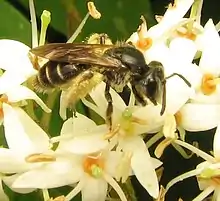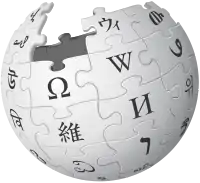oligolecty
English
WOTD – 21 June 2021
Etymology

The dogwood andrena (Andrena, subgenus Gonandrena) exhibits oligolecty as it pollinates only dogwoods (Cornus).
Probably from oligolectic + -y (suffix forming abstract nouns denoting conditions, qualities, or states). Oligolectic is derived from English oligo- (prefix meaning ‘few’) (from Ancient Greek ὀλῐ́γος (olígos, “few, little”), from Proto-Indo-European *(o)leyg- (“indigent, poor; miserable”)) + Ancient Greek λεκτός (lektós, “chosen”) (from λέγω (légō, “to choose; to arrange; to gather”), from Proto-Indo-European *leǵ- (“to collect, gather”)) + English -ic (suffix forming adjectives meaning ‘of or pertaining to’ from nouns), possibly modelled after eclectic.[1]
Pronunciation
- (Received Pronunciation) IPA(key): /ˌɒlɪɡə(ʊ)ˈlɛkti/, /ɒˌlɪɡə(ʊ)-/
Audio (Southern England) (file) - (General American) IPA(key): /ˌɑləɡoʊˈlɛkti/, /ˌoʊ-/, /əˌlɪɡə-/
Audio (US) (file) - Hyphenation: oli‧go‧lecty
Noun
oligolecty (uncountable)
- (entomology) The preference of an insect pollinator (chiefly a bee) for pollinating only a few plant species.
- 1944 April 10, Charles Duncan Michener, “Comparative External Morphology, Phylogeny, and a Classification of the Bees (Hymenoptera)”, in Bulletin of the American Museum of Natural History, volume 82, article 6, New York, N.Y.: American Museum of Natural History, ISSN 0003-0090, OCLC 715282927, part 2 (Comparative External Morphology of the Bees), page 218, column 2:
- We have, thus, a case where different types of bees are similarly adapted to oligolecty on a certain group of plants.
- 1954 June 21, Charles D[uncan] Michener, “Bees of Panamá”, in Bulletin of the American Museum of Natural History, volume 104, article 1, New York, N.Y.: American Museum of Natural History, ISSN 0003-0090, OCLC 715282927, page 6, column 2:
- The most likely explanation for oligolecty in bees is not different from the explanation of specificity of any organism to its habitat; in fact, oligolecty is a form of host specificity.
- 1955 October, E[arle] G[orton] Linsley; J[ohn] W[inslow] MacSwain; Ray F[red] Smith, “Observations on the Nesting Habits and Flower Relationships of Some Species of Melandrina (Hymenoptera: Andrenidae)”, in P. D. Hurd, Jr., editor, The Pan-Pacific Entomologist, volume XXXI, number 4, San Francisco, Calif.: Pacific Coast Entomological Society, ISSN 0031-0603, OCLC 979171155, page 175:
- In so far as now known, all of the species exhibit a high degree of oligolecty (or monolecty) being restricted in pollen collecting to a single genus of plants.
- 1974, Charles D[uncan] Michener, “Glossary”, in The Social Behavior of the Bees, Cambridge, Mass.: The Belknap Press of Harvard University Press, →ISBN, page 373, column 1:
- An individual of a polylectic species that takes pollen from only a few kinds of plants is showing flower constancy rather than oligolecty.
- 1978, Daniel F. Austin, “Morning Glory Bees and the Ipomoea pandurata Complex (Hymenoptera: Anthophoridae)”, in Manya B. Stoetzel, editor, Proceedings of the Entomological Society of Washington, volume 80, number 3, Washington, D.C.: Entomological Society of Washington, ISSN 0013-8797, OCLC 1253434415, page 397:
- Once oligolecty was documented, the following two summers were used for field study of widely separated populations of I. pandurata.
- 2006, James H. Cane; Sedonia Sipes, “Characterizing Floral Specialization by Bees: Analytical Methods and a Revised Lexicon for Oligolecty”, in Nickolas M. Waser and Jeff Ollerton, editors, Plant–Pollinator Interactions: From Specialization to Generalization, Chicago, Ill.; London: University of Chicago Press, →ISBN, part II (The Ecology and Evolution of Specialized and Generalized Pollination), page 110:
- That oligolecty exists is indisputable, but its application to particular bee species engenders confusion and debate. […] We propose a definition of oligolecty that is sufficiently inclusive without diluting the intended meaning for undisputed cases: we define oligolecty as consistent and predictable reliance of a species on a few plant genera for their pollen needs.
- 2018, Favio Gerardo Vossler, “Are Stingless Bees a Broadly Polylectic Group? An Empirical Study of the Adjustments Required for an Improved Assessment of Pollen Diet in Bees”, in Patricia Vit, Silvia R. M. Pedro, and David W. Roubik, editors, Pot-pollen in Stingless Bee Melittology, Cham, Switzerland: Springer Nature, DOI:, →ISBN, part I (Pollen and the Evolution of Mutualism), section 2.2 (Pollen Specialization Categories in Bees), page 19, column 1:
- In most studies sampling is limited to a few sites, and therefore oligolecty is dubiously assigned. Moreover, both abundant and minor pollen types are generally considered at a same level of importance.
- 2020, R. G. Vastrad, “Specialized Bees Fail to Develop on Non-host Pollen: Do Plants Chemically Protect Their Pollen?”, in A Study of Floral Specialization in Solitary Bees, Raleigh, N.C.: Lulu, →ISBN, page 31:
- The two most basal bee families, Dasypodaidae and Mellitidae, are predominantly composed of pollen specialists, indicating that oligolecty might be the ancestral state in bees […]. In the western Palaearctic anthidiine bees, several transitions from oligolecty to polylecty were found, but none from polylecty to oligolecty […].
-
Hyponyms
- monolecty
Coordinate terms
- mesolecty
- polylecty
Related terms
- oligolectic
- oligolege
Translations
preference of an insect pollinator for pollinating only a few plant species
|
See also
- oligotropic
References
- “oligolectic, adj.” under “oligo-, comb. form”, in OED Online
 , Oxford, Oxfordshire: Oxford University Press, March 2021; “oligolectic, adj.”, in Lexico, Dictionary.com; Oxford University Press, 2019–2022.
, Oxford, Oxfordshire: Oxford University Press, March 2021; “oligolectic, adj.”, in Lexico, Dictionary.com; Oxford University Press, 2019–2022.
Further reading
 oligolecty on Wikipedia.Wikipedia
oligolecty on Wikipedia.Wikipedia